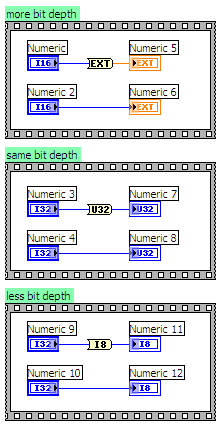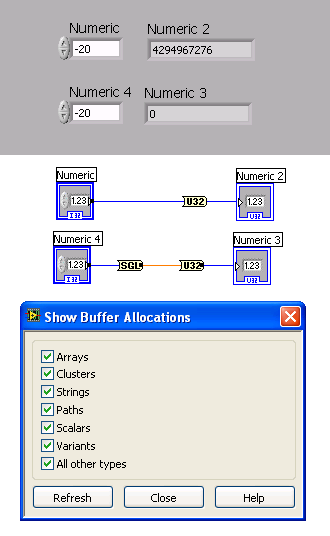- Subscribe to RSS Feed
- Mark Topic as New
- Mark Topic as Read
- Float this Topic for Current User
- Bookmark
- Subscribe
- Mute
- Printer Friendly Page
Type conversion and inplaceness ?
08-17-2007 03:34 AM - edited 08-17-2007 03:34 AM
- Mark as New
- Bookmark
- Subscribe
- Mute
- Subscribe to RSS Feed
- Permalink
- Report to a Moderator
I've been wondering for a long time if type conversion was inplace
In the example below, is there any case were inplaceness will happen ?

My feeling is that :
- no inplaceness when there is a conversion dot,
- when converting to a representation with a larger bit depth, I believe inplaceness is not possible,
- when converting to a representation with the same bit depth, I believe inplaceness is possible,
- when converting to a representation with a smaller bit depth, I believe inplaceness is not possible.
Is that correct (speaking in LV 7.1.1) ?
What if put the same code in a LV 8.5 inplace structure ?
Message Edité par TiTou le 08-17-2007 10:37 AM
We have two ears and one mouth so that we can listen twice as much as we speak.
Epictetus
08-17-2007 06:03 AM - edited 08-17-2007 06:03 AM
- Mark as New
- Bookmark
- Subscribe
- Mute
- Subscribe to RSS Feed
- Permalink
- Report to a Moderator
I would think the same as you already noted:
inplaceness is only possible when the bit-length is the same (think about arrays of numbers!).
But "possible" doesn't mean it is "done" inplace... And it is still up to LV to get a proper algorithm to do the conversion "inplace".
I haven't tested the LV8.5 until now, but I think the inplace-struture only works when the datatype isn't changed inside!
Message Edited by GerdW on 08-17-2007 01:05 PM
08-17-2007 06:41 AM
- Mark as New
- Bookmark
- Subscribe
- Mute
- Subscribe to RSS Feed
- Permalink
- Report to a Moderator
We have two ears and one mouth so that we can listen twice as much as we speak.
Epictetus
08-17-2007 08:04 AM - edited 08-17-2007 08:04 AM
- Mark as New
- Bookmark
- Subscribe
- Mute
- Subscribe to RSS Feed
- Permalink
- Report to a Moderator

Message Edited by altenbach on 08-17-2007 06:07 AM
Message Edited by altenbach on 08-17-2007 06:11 AM
08-17-2007 08:08 AM - edited 08-17-2007 08:08 AM
- Mark as New
- Bookmark
- Subscribe
- Mute
- Subscribe to RSS Feed
- Permalink
- Report to a Moderator
What version is your example Christian?
I just did the same experiment (I32 > U32) in LV 7.1 and got dots.
Ben
Message Edited by Ben on 08-17-2007 08:08 AM
08-17-2007 08:14 AM - edited 08-17-2007 08:14 AM
- Mark as New
- Bookmark
- Subscribe
- Mute
- Subscribe to RSS Feed
- Permalink
- Report to a Moderator
This is in 8.2.1.
If you convert -20 to U32, do you get 0 or 4294967276 ? Just curious.
Message Edited by altenbach on 08-17-2007 06:15 AM
08-17-2007 08:17 AM
- Mark as New
- Bookmark
- Subscribe
- Mute
- Subscribe to RSS Feed
- Permalink
- Report to a Moderator
Smart test Christian !
We have two ears and one mouth so that we can listen twice as much as we speak.
Epictetus
